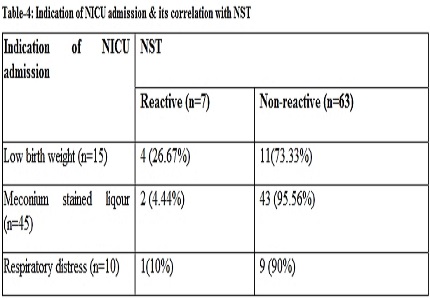Correlation of cardiotocography results and perinatal outcome in gestational hypertension
Abstract
Background: Early recognition of foetal distress in labour is the primary concern for the obstetrician to avoid adverse perinatal outcome. cardiotocograph is a simple non-invasive test that can serve as a screening tool in assessing foetuses of high risk obstetric patients. Use of electronic FHR monitoring during labour can detect hypoxia timely & unnecessary delay in intervention can be avoided.
Methods: Study was conducted at NSCB MCH Jabalpur, Department of obstetrics & Gynaecology. Total 200 patients selected who were admitted for hypertensive disorder & were included in the study. NST was used for fetal surveillance from 32 weeks of gestation weekly, biweekly, alternate day & daily basis depending on the severity of gestation. patients were followed till delivery & maternal & foetal outcome recorded & correlated with CTG findings.
Result: Out of 200 patients 107 delivered by LSCS & most of these cases had non-reactive NST 70/107& 93 delivered by Vaginal route & most of them have reactive NST 71/93.In non-reactive NST group newborns APGAR score at 5 minute<7 in 40/92 cases while in reactive NST group it was in 30/102 cases. Total 70 new-born admitted in NICU out of which 63 were from nonreactive group & 7 were from reactive group.
Conclusion: CTG can serve as a screening tool in high risk obstetric pregnancy, particularly in preeclampsia where decrease utero-placental circulation cause considerable fetalcompromise. It helps to detect fetal distress already present or likely to develop during labour.
Downloads
References
2. Damian Hutter,John Kingdom, and Edgar Jaegg. Causes and Mechanisms of Intrauterine Hypoxia and Its Impact on the Fetal Cardiovascular System: A Review. international Journal of Pediatrics. Volume 2010 (2010), Article ID 401323, 9 pages.
3. Kwame Adu-Bonsaffoh, Michael Y. Ntumy,Samuel A. Obed, and Joseph D. Seffah et al. Perinatal outcomes of hypertensive disorders in pregnancy at a tertiary hospital in Ghana. BMC Pregnancy Childbirth. 2017; 17: 388 DOI 10.1186/s12884-1575-2.
4. J.R. Barton, L. A. Barton, N. B. Istwan . Elective delivery at 34 to 36 weeks’ gestation and its impact on neonatal outcomes in women with stable mild gestational hypertension,American Journal of Obstetrics and Gynecology.2011;204:44.e1-5.
5. Trupti J, Dhakare and Kiran P Patole. A Study of Cardiotocography during Active Labour to Assess the Perinatal Outcome in High Risk Pregnancy. MVP Journal of Medical Sciences, 2016;Vol 3(2):92-95.
6. National institute of clinical excellence intrapartum care .Care of health women and their babies during labour.Nice clinical guideline No.55 september 2007.
7. GpCapt GS Sandhu, VSM, R Raju, Col TK Bhattacharyya, Lt Col Shaktivardhan. Admission Cardiotocography Screening of High Risk Obstetric Patients. MJAFI 2008; 64 : 43-45.
8. Buscicchio G, Gentilucci L, Tranquilli AL. Computerized analysis of fetal heart rate in pregnancies complicated by gestational diabetes mellitus, gestational hypertension, intrauterine growth restriction and premature rupture of membranes. J MaternFetal Neonatal Med. 2010 Apr;23(4):335-7. doi: 10.3109/14767050903258712. [PubMed]
9. Backes CH, Markham K, Moorehead P, Cordero L, Nankervis CA, Giannone PJ. Maternal preeclampsia and neonatal outcomes. J Pregnancy. 2011;2011:214365. doi: 10.1155/2011/214365. Epub 2011 Apr 4. [PubMed]
10. PijnenborgR, Anthony J, Davey DA, Rees A, Tiltman A, Vercruysse L, van Assche A. Placentalbedspiralarteries in the hypertensivedisorders of pregnancy. Br J ObstetGynaecol. 1991 Jul;98(7):648-55.
11. Roberts JM, Escudero C. The placenta in preeclampsia. Pregnancy Hypertens. 2012 Apr 1;2(2):72-83. [PubMed]
12. Barunoday Chakraborty, Tamal Kumar Mondal, Sannyasi Charan Barman, BiswaPratim Rudra, RamkrishnaSahana, Prabhat Chandra Mondal. Evaluation of Perinatal Outcome by Antenatal CTG and Umbilical Artery Doppler in Pre-eclamptic Mothers. Indian Journal of Clinical Practice.2013; Vol. 24, No. 6.
13. Lawrence E. R., Quarshie E. L., Lewis, K. F. Peltzman, T., & Anderson F. J. Introduction of cardiotocograph monitoring improves birth outcomes in women with preeclampsia in Ghana. International Journal of Gynecology and Obstetrics.2016; 132(1), 103-104.
14. Lawn JE, Blencowe H, Waiswa P, Amouzou A, Mathers C, Hogan D, Flenady V, Frøen JF, Qureshi ZU, Calderwood C, Shiekh S, Jassir FB, You D, McClure EM, Mathai M, Cousens S; Lancet Ending Preventable Stillbirths Series study group; Lancet Stillbirth Epidemiology investigator group. Stillbirths: rates, risk factors, and acceleration towards2030. Lancet. 2016 Feb 6;387(10018):587-603. doi: 10.1016/S0140-6736(15)00837-5. Epub 2016 Jan 19. [PubMed]
15. Vogel JP, Souza JP, Mori R, Morisaki N, Lumbiganon P, Laopaiboon M, Ortiz-Panozo E, Hernandez B, Pérez-Cuevas R, Roy M, Mittal S, Cecatti JG, Tunçalp Ö, Gülmezoglu AM; WHO Multicountry Survey on Maternal and Newborn Health Research Network. Maternal complications and perinatal mortality: findings of the World Health Organization Multicountry Survey on Maternal and Newborn Health. BJOG. 2014 Mar;121 Suppl 1:76-88. doi: 10.1111/1471-0528.12633.
16. Manisha Gupta , Teena Nagar, Punit Gupta. Role of Cardiotocography to Improve Perinatal Outcome in High Risk Pregnancy. International Journal of Contemporary Medical Research ISSN. Volume 4 | Issue 4 | April 2017;2454-7379 | ICV (2015): 77.83.

Copyright (c) 2018 Author (s). Published by Siddharth Health Research and Social Welfare Society

This work is licensed under a Creative Commons Attribution 4.0 International License.


 OAI - Open Archives Initiative
OAI - Open Archives Initiative



















 Therapoid
Therapoid

